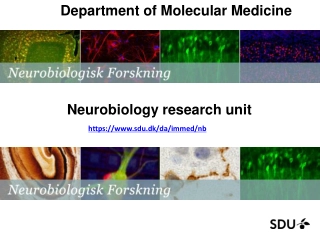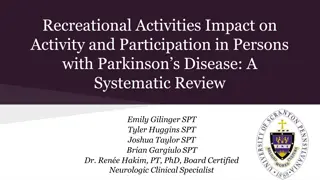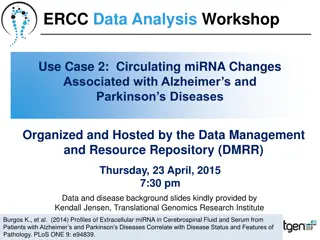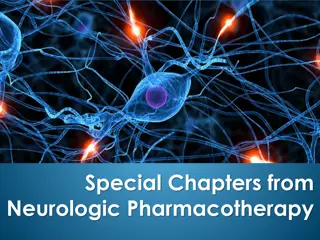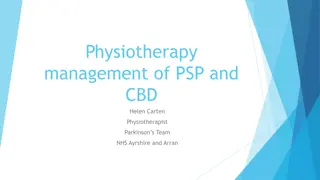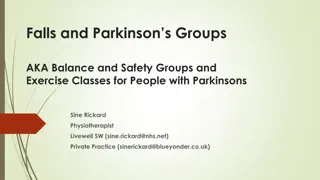
Parkinson's Disease - Symptoms and Causes
Parkinson's disease is a chronic, progressive nervous system disorder resulting from the degeneration of dopamine-producing cells in the substantia nigra. Commonly known as Paralysis agitans or True PD, it manifests through rigidity, bradykinesia, tremors, and postural instability.
Download Presentation

Please find below an Image/Link to download the presentation.
The content on the website is provided AS IS for your information and personal use only. It may not be sold, licensed, or shared on other websites without obtaining consent from the author. If you encounter any issues during the download, it is possible that the publisher has removed the file from their server.
You are allowed to download the files provided on this website for personal or commercial use, subject to the condition that they are used lawfully. All files are the property of their respective owners.
The content on the website is provided AS IS for your information and personal use only. It may not be sold, licensed, or shared on other websites without obtaining consent from the author.
E N D
Presentation Transcript
A chronic, progressive disease of the nervous system due to degeneration of dopamine- producing cells in the substantia nigra characterized by rigidity, bradykinesia, resting tremor, and postural instability
Other names: Paralysis agitans True PD Idiopathic Parkinson s disease Shaking palsy
Extrapyramidal system eliminates unwanted movements for smooth voluntary motor activity 1. Basal ganglia 2. Subthalamic nucleus 3. Substantia nigra 4. Reticular formation 5. Red nucleus
Cell bodies in the basal ganglia 1. Putamen 2. Globus pallidus regulates muscle tone 3. Caudate nucleus - coordination Striatum/Neostriatum (controls large subconscious movements) = caudate nucleus + putamen Paleostriatum/Pallidum = globus pallidus Lenticular nucleus = globus pallidus + putamen Corpus striatum = lenticular nucleus + caudate nucleus
Dopamine main inhibitory neurotransmitter from the basal ganglia Acetylcholine main excitatory neurotransmitter within the corpus striatum Circuit involved in PD: Striatum Substantia Nigra Thalamus Cerebral Cortex
58-62 y/o mean age of onset M > F Kyphosis most common postural deformity Pneumonia one of the leading causes of death
Parkinsonism produce abnormalities of the basal ganglia function 1. Primary parkinsonism 2. Secondary parkinsonism results from a number of different causes 3. Parkinson- -plus syndromes symptoms of multiple system degeneration Parkinsonism a group of disorders that Primary parkinsonism most common cause 1. 2. Secondary parkinsonism 3. Parkinson plus syndromes conditions with
Parkinsons True PD, , paralysis agitans, shaking palsy Groups: Postural instability gait disturbed Tremor predominant Parkinson s disease disease Idiopathic parkinson s disease
1. 1. Post infection Encephalitis Presence of headache and drowsiness progressing to coma Cryptococcal caused by Cryptococcus Post- -infectious parkinsonism infectious parkinsonism caused by viral Encephalitis lethargica lethargica sleeping sickness Cryptococcal meningitis meningitis inflammation of meninges 2. 2. Toxic parkinsonism chemicals Manganese most common Synthetic heroin causes severe parkinsonism Toxic parkinsonism from industrial poisons and
3. Pharmacological interfere with dopaminergic mechanisms Neuroleptic drugs Antidepressant drugs Antihypertensive drugs * * withdrawal of these agents usually reverses the symptoms 3. Pharmacological parkinsonism parkinsonism drugs that 4. Metabolic calcium metabolism that result in basal ganglia calcification Hypothyroidism decrease secretion of thyroxine, triiodothyronine, and calcitonin which are essential for normal metabolism and growth 4. Metabolic parkinsonism parkinsonism caused by disorders of
1. 1. Akinetic features A group of neurodegenerative disease that can affect the substantia nigra and produce parkinsonian symptoms Striatonigral degeneration, Shy-drager syndrome (early autonomic failure), huntington s disease (hereditary disease caused by a defect in a single gene with symptoms of unsteady gait and jerky involuntary movements [chorea]) Akinetic/rigid syndromes with features /rigid syndromes with parkinsonian parkinsonian
Degeneration of dopaminergic neurons Decrease dopamine production 80% degeneration: signs become evident Loss of melanin-containing neurons Changes in depigmentation Progression: development of Lewy s bodies Loss of dopaminergic neurons Loss of inhibitory influences decrease binding sites for dopamine loss of effectiveness of L-dopa Tremor, rigidity
Cardinal features: Rigidity Bradykinesia Resting tremor Postural instability Cardinal features: Triad of PD: Rigidity Bradykinesia Resting tremor Triad of PD:
resistance to passive motion; not velocity dependent Felt uniformly in muscles on both sides of the joint Usually affects asymmetrically Affects proximal muscles first, especially the shoulder and neck. Progresses to the face and extremities loss of arm swing during gait and loss of bed mobility Caused by damage to the globus pallidus, dopamine, acetylcholine Types: 1. Cogwheel jerky, ratchetlike resistance to passive movement as the muscles alternately tense and relax Leadpipe constant, uniform resistance without fluctuations 2.
Websters rating scale for rigidity: 0 no involvement 1 Detectable rigidity in the neck and shoulder. One or both arms show mild, negative, resting rigidity 2 Moderate rigidity in the neck and shoulder. Presence of resting rigidity 3 Severe rigidity in the neck and shoulder. Resting rigidity cannot be relieved by medications
s slowness of movement Akinesia severe form When it affects the facial muscles masked facies (hypomimia) speed, range, amplitude Inability to change direction while walking, difficulty walking around objects, difficulty standing Influenced by rigidity and depression Involvement of muscles innervated by cranial nerves III, VII, IX Due to failure of the basal ganglia to integrate sensory information so that motor planning and facilitation of movement are altered
Grading for bradykinesia: 0 absent 1 minimum slowness 2 moderate slowness, poverty of movement 3 marked slowness, poverty of movement, hesitancy, arrest of ongoing movement 4 severe slowness, poverty of movement, unable to move all 4 limbs simultaneously Webster s rating scale for bradykinesia of the hands: 0 no involvement 1 detectable slowing of pronation-supination rate evidenced by difficulty in handling tools, buttoning clothes and writing 2 moderate slowing of pronation-supination rate evidenced by moderate impairment of hand functions. Writing is greatly impaired including micrographia 3 severe slowing of pronation-supination rate. Patient is unable to write or button clothes
involuntary oscillation of a body part at rest Most common complaint and initial symptom Begins as pill-rolling tremor of the index finger and thumb Usually disappears during voluntary movement Postural tremor (head and trunk) can be seen when muscles are used to maintain an upright position against gravity. In the LE, tremor is felt during supine position Due to decreased levels of serotonin
Grading for tremor: 0 no detectable tremor 1 less than 1 inch of peak-to-peak movement at rest in the limb 2 maximum tremor envelope of not more than 4 inches. Tremor is severe but constant and the pt retains some control of the hand 3 tremor enveloped over 4 inches. Tremor is constant and severe. Pt cannot get free from tremor while awake. Writing and feeding are impossible
most disabling, least specific due to degeneration of globus pallidus balance is lost due to loss of reactive processes needed to adjust posture and regain equilibrium extensor muscles of trunk demonstrate greater weakness, resulting to a flexed, stooped posture with increased flexion of the neck, trunk, hips, and knees pt falls backward or to the side tandem stance narrowing of BOS abnormal pattern of coactivation, insufficient neural activation of agonist muscles, delayed muscle recruitment and that once initiated is characterized by asynchronization kyphosis most common postural deformity
Start hesitation difficulty initiating when, where and how to move Micrographia abnormally small handwriting Freezing episodes (motor blocks) Hypomimia reduction in expressiveness of the face Myerson s sign a sustained blink response produced after repetitive tapping over the bridge of the nose Decreased motor learning Festinating gait increased speed, decreased stride. Pt take multiple short steps to catch up with his COM to avoid falling Paresthesia and pain usually in the tight shoulders as a result from postural stress syndrome secondary to lack of movement, rigidity, and faulty posture Dysphagia Sialorrhea excessive drooling Hypokinetic dysarthria decreased voice volume, monotone speech, distorted articulation and uncontrolled speech rate Dementia Depression Impaired ANS Orthostatic hypotension Airway obstruction Restrictive lung dysfunction 1. 2. 3. 4. 5. 6. 7. 8. 9. 10. 11. 12. 13. 14. 15. 16. 17.
At least 2 of the 4 cardinal features are present Exclusion of Parkinson-plus syndromes is necessary (presence of extrapyramidal signs that are bilateral symmetrical and do not respond to L-dopa and dopamine agonists)
1. MRI 2. Positron emission tomography 3. Single-photon emission computerized tomography
Presence of tremor, festinating gait, flexed stooped posture, expressionless face, rigidity, babinski reflex, hyperreflexia, micrographia Loss of hip and knee extension, ankle dorsiflexion, shoulder flexion, elbow extension, dorsal spine and neck extension, and axial rotation during ROM Slow movement Excessive drooling or sweating Tonal changes in the shoulder and neck, trunk and extremities Rapid, monotonous, low volume with poor articulation in speech 1. 2. 3. 4. 5. 6.
Levodopa (L-dopa) mainstay of symptomatic treatment A metabolic precursor of dopamine that is able to cross the BBB and raise the level of striatal dopamine in the BG Commonly administered with CARBIDOPA, which allows a higher percentage of L-dopa to enter the CNS L-dopa is usually metabolized before reaching the brain SINEMET most common carbidopa/L-dopa medication; alleviates bradykinesia and rigidity, less effect on tremor Selegiline delays the primary endpoint at which pts need to start taking L-dopa Monoamine oxidase inhibitor (drug class) Once L-dopa therapy is started, selegiline in combination permits a lower dose to be used
Dopamine agonists act directly on the postsynaptic dopamine receptors Example: bromocriptine Reduces rigidity and bradykinesia Anticholinergics used in early, untreated PD Block cholinergic function and have the most benefit moderating tremor and rigidity Examples: trihexyphenidyl, bentropin
Indications: 1. pts with advanced PD who respond poorly to medications 2. pts who experience complications related to pharmacotherapy
Stereotactic surgery surgical lesioning of the brain Pallidotomy producing a destructive lesion in the sensorimotor portion of the globus pallidus internus which produces excessive GPi inhibitory activity that results in tonic thalamic hypoactivity; indicated for rigidity and tremor Thalamotomy producing a destructive lesion within the ventral intermediate nucleus of the thalamus; reduces longstanding tremor, improvement of rigidity Deep brain stimulation implantation of electrodes into the brain where they block nerve signals that cause symptoms Neural transplantation transplantation of cells capable of surviving and delivering dopamine into the striatum of pts with advanced PD; stem cells?????
Hoehn and Yahr Classification of Disability Stage I - Minimal or absent; unilateral if present Tremor of 1 limb Decreased arm swing Micrographia hypophonia
Stage II - Minimal bilateral or midline involvement; balance not impaired Sx s evident in Stage I, plus Bradykinesia Stoop posture Shuffling gait
Stage III - Impaired righting reflex; unsteadiness when turning or rising from the chair; some activities are restricted but pt is independent Sx s evident in Stages I & II, plus Pronounced gait disturbance Moderate general disability
Stage IV - All symptoms present and severe; standing and walking possible only with assistance Sx s evident in Stages I, II & III, plus Significant disability
Stage V - Confined to bed or wheelchair Sx x evident in Stages I, II, III & IV, plus Complete invalidism
Positive prognostic features: 1. Early tremor 2. Rigidity 3. Family history Negative prognostic features: 1. Bradykinesia 2. Akinesia 3. Postural instability 4. Gait difficulties 5. Cognitive defects 6. Late age of onset
Relaxation techniques A rocking chair is a good tool for pt relaxation Rhythmic initiation Jacobson s progressive relaxation techniques contract-relax Lower trunk rotation with the pt hook-lying to relax trunkal rigidity
ROM and mobility exercises ROM should focus on strengthening the weak extensor muscles and stretch the tight flexor muscles Prone-on-elbows and prone-on-extension improve thoracic extension PJM to decrease tightness of joint capsule Bilateral symmetrical D2 flexion pattern activates extensors in order to straighten the spine Standing balance with rhythmic stabilization
Breathing exercises emphasis on diaphragmatic breathing Clinical restorator for conditioning Gait training Lengthen stride, widen the BOS Increase contralateral trunk movement and arm swing Place markers or blocks to help encourage the pt to widen the stride and avoid shuffling the feet PRE s US over the tight structures especially the shoulder HMP FES emphasis on weak extensor muscles HEP walking exercise
Relentless, progressive, adult-onset, autosomal dominant disorder that is associated with cell loss within a specific subset of neurons in the caudate nucleus and putamen Cardinal features: involuntary movements, dementia, and behavioural changes Clinical onset usually 30-50 years of age, fatal outcome usually within 15-20 years Caused by mutant huntingtin Pneumonia and cardiovascular changes most common primary causes of mortality Depression most common psychological dysfunction Hallmark: Chorea excessive abrupt irregular spontaneous involuntary movements Westphal variant: hypokinesia and rigidity Chorea does not respond to physical therapy
can result from disorders of the cerebellum or its connections Friedreich ataxia most common syndrome. It is a progressive disorder with the presentation of limb and gait ataxia with diminished muscle stretch reflexes, joint position sense, and vibratory appreciation
a group of inherited disorders in which the primary symptoms are progressive bilateral lower extremity spasticity and weakness caused by axonal degeneration in the spinal cord, maximally in the corticospinal tracts and the dorsal column fibers Other names: familial spastic paraplegia, Strumpell- Lorrain syndrome Progressive difficulty walking classic presenting symptom Cardinal features: symmetric lower extremity spastic paresis, extensor plantar responses Tx: cold application, manual stretching techniques, splinting, serial casting, posture and body mechanics training, aerobic conditioning, and gait and dynamic balance training
movement disorder characterized by muscle contraction resulting in twisting, turning, and posturing as a result of sustained co- contraction of the agonist and antagonist Tx: massage, slow stretching, US, gait training and mobility
a constellation of symptoms including tic disorders and comorbid neurobehavioral problems Tics involuntary, sudden, rapid, repetitive, non-rythmic, stereotyped movements or vocalizations Commonly involves the face, head and shoulders (sniffing, blinking, frowning, shoulder shrugging, head thrusting)

